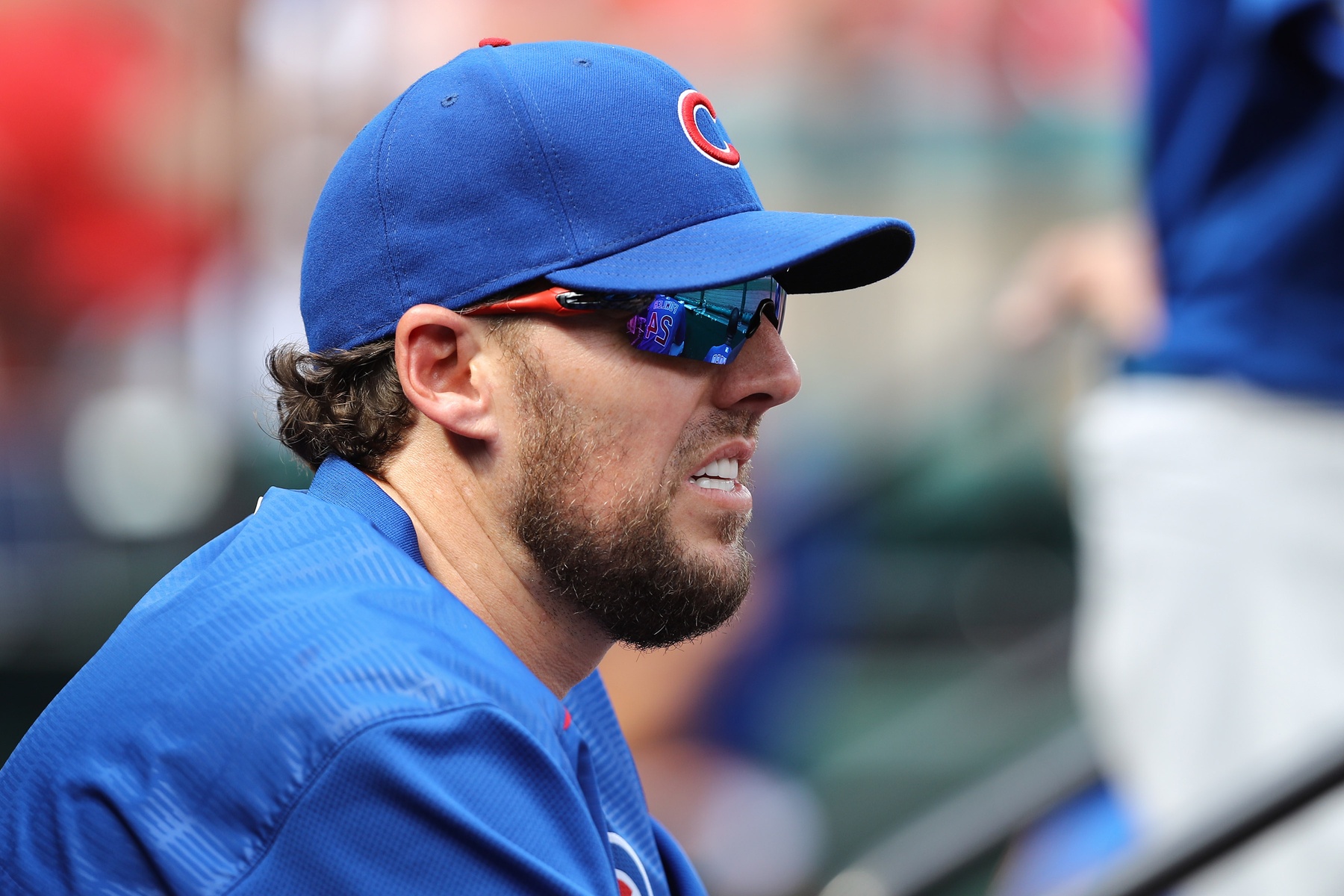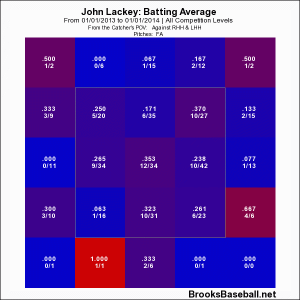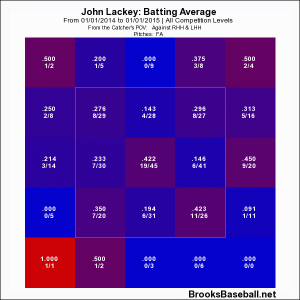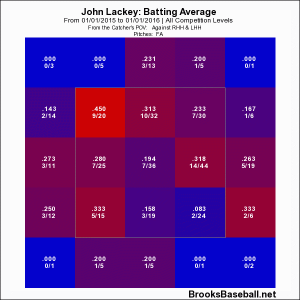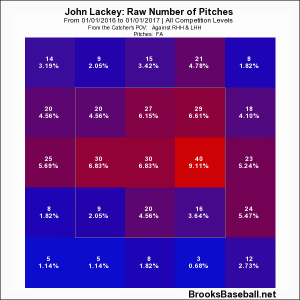Lately, there haven’t been many game days in which Cubs fans wake up and wonder which version of the starting pitcher they’re going to see that evening. The Cubs rotation in 2016 has not just been good, it’s been exceptionally reliable in many ways.
But going into the season, the potential for that head-scratcher day was most likely going to be when John Lackey’s turn in the rotation came up. Cubs fans just weren’t sold on the idea of Lackey so quickly. Maybe it was the anti-Cardinals bias, maybe it was the risk involved in a 37-year-old starter who underwent Tommy John surgery four years ago.
Lackey was signed before the 2015 annual Winter Meetings took place, which sparked hesitation and curiosity as to why the Cubs would fill such an important role in the rotation and overall in the organization in a manner that felt somewhat rash.
But never underestimate the stealth approach of Theo Epstein & Company. Epstein had a bevy of reasons to feel that Lackey was the man for the task so early on, and seized the opportunity to make a deal at a bargain before the market dictated the price of a pitcher. Some of these reasons include, but are not limited to:
- Lackey had worked briefly under Epstein in Boston during the 2010 and 2011 seasons, thus making the organization familiar with him.
- Lackey spent time working with veteran catcher David Ross for nearly two seasons in Boston, helping strengthen their pitcher/catcher relationship from the start.
- Lackey has history dating back to the early 2000s in Anaheim with Joe Maddon, when Maddon served as Mike Scoscia’s bench coach.
- Lackey has two World Series rings from prestigious baseball organizations, and a good amount of postseason experience on his resume—both positive, and more recently, negative.
- At age 37, Lackey has been around the block a few times, handling everything from Tommy John surgery to winning two World Series, and can provide a complementary clubhouse personality and presence to the likes of David Ross, Ben Zobrist, etc. to this young core of players.
Yes, I noted Lackey’s personality as a positive. Lackey may not have the polished and shining baseball reputation that Ben Zobrist brings to the Cubs, but the reality of life is that not everything is sunshine and lollipops, and Joe Maddon would be the last person to try and shelter this group of young minds from the fact that baseball life is as much about the fanfare, success, and celebrity these players are experiencing right now as it is about being yourself, grinding out, and sometimes suffering a few scars (literally) along the way—the type of experience and persona that Lackey is well equipped to contrast this clubhouse with.
But enough about the intangibles that made Lackey more than a suitable decision for the Cubs’ third starter role. Upon word of the Lackey signing, my hesitation was a bit more performance-related.
The two major concerns that I had regarding Lackey were that, first, he was entering his age 37 season (he will be 38 in October) while also coming off one of the best seasons of his career, leaving the potential for regression looming large. Secondly, I thought that his recent struggles with his fastball command might be a concern coming to hitter-friendly Wrigley Field.
Lackey’s numbers in 2015 with the Cardinals may have been exceptional, but when looking at them in the context of his career, they weren’t exactly outliers. Lackey kept his walk rate low, kept the ball on the ground, and stranded runners on base at a career-high clip of 82 percent in order to post his career lowest ERA of 2.77 in 2015.
So you could say that for 2016 to be as successful as it has been for Lackey wasn’t exactly unexpected, the major concern was the age regression monster—which he’s been able to fend off quite gracefully this season. One of Lackey’s major contributions this season has also been his ability to be the inning eater that he has been in the past, and the one that the Cubs needed in the middle of this rotation. Lackey has gone seven or more innings in six of his ten outings on the season so far.
The 6-foot, 6-inch Texas right-hander is currently striking out batters at a 25 percent clip which is, at the moment, a career high. This has mostly been due in part to his slider being an absolutely exceptional out pitch for him. The sample size may still be small, but take a look at how much Lackey has improved his slider this season as compared to 2015:
| Ball% | Strike% | Swing% | Whiff% | |
| 2015 | 32.4 | 29.7 | 57.3 | 20.1 |
| 2016 | 27.8 | 36.7 | 63.7 | 28.3 |
Lackey has never posted whiff or strike rates this exceptional on the pitch for as far back as Brooks Baseball data goes (2004), and his second highest whiff rate on the pitch, of 21.4 percent, dates back to 2004 itself. So, now all those strikeouts that Lackey has been stacking up start after start seem to make a little more sense when you see how much his slider has improved. Right now, Lackey is seeing the most vertical movement on his slider since 2010.
Lackey still has a HR/FB rate of 11.1 percent in 2016, which is more in line with his career norms since his return from Tommy John surgery in 2013. In 68 innings of work so far, Lackey has allowed seven home runs, which keeps him on pace for what was to be expected from him—somewhere around 20-22 balls straying into the bleacher seats.
It’s hard to definitively quantify defense in baseball, as there just aren’t yet completely reliable statistics to grade this type of performance on. But for what it’s worth, using the statistics we have now, the Cubs currently rank number one in the categories of UZR, UZR/150, and DRS—another large contribution to Lackey’s success during times where he could possibly have gotten into some bad jams with his heavily-relied upon fastball.
In 2015 when Lackey was pitching with the Cardinals, their defense ranked fourth and fifth in each of those three categories, leaving more room for error when batters made contact on his fastball. Lackey has seen a drop in his BABIP this season, going from .295 in 2015 to .250 with the Cubs. Though pitcher BABIP is hard to draw any meaningful or concrete evidence from, we can gather a bit of context from it when adding the fact that this number as of right now may not be a complete fluke due to the undeniable fact that the defense behind Lackey is much improved. This has helped lead Lackey to the 3.16 ERA coupled with a nearly identical FIP of 3.36 (we can also assume that most of the gap there is due to the home runs Lackey has allowed).
Lackey’s fastball has improved though, and we can only credit the improvement in Lackey’s repertoire to the magic hands of Chris Bosio. Take a look at the batting average maps on Lackey’s fastball each year since his return from Tommy John surgery:
As you can see, the contact being made on the pitch got progressively worse over the years, giving Lackey the most trouble last season when leaving the pitch up in the zone.
But this year, the story isn’t quite the same.
Lackey is still elevating the pitch a bit more than one would like to see (especially when it tops out at just around 93 mph these days), but his major weakness is when he leaves the ball over the heart of the plate, however, that’s an issue any pitcher would face when it comes to their fastball location.
The quality of Lackey’s fastball hasn’t necessarily improved a ton, but the improvement of his slider to induce whiffs on batters coupled with the Cubs’ exceptional defense have aided in helping enhance the abilities Lackey still has to offer and make him a reliable starter.
Sometimes the little adjustments are everything, and seeing that Lackey certainly still has the makeup to be a successful contributor to this rotation when certain adjustments are made has helped put Lackey in the best position to succeed at age 37, and for the Cubs to find reliability in one of the most important areas of their rotation. The Cubs have found a way to turn Lackey into one of the most valuable additions in this role and to this 2016 team.
Lead photo courtesy Billy Hurst—USA Today Sports.
